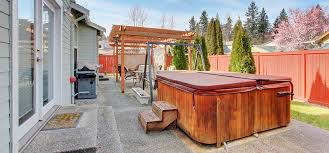
We just looked at two types of hot tubs:
- One embedded in a wooden patio deck,
- Another portable, inflatable hot tub that could be easily moved.
In the first case, the conclusion was that it qualified to be a fixture, and the second one remained a chattel.
Now, we are going to look at one in the middle. This one falls into a grey area.
Bob goes to a hot tub store and buys a $10,000 hot tub. It is delivered and placed on top of concrete patio stones in the rear yard.
It needs three (3) things from the house:
- Water,
- Electricity, and
- Gas.
The water is supplied by a garden hose. An electrical cord is used for electricity for the pump and the heater and a gas line supplies the gas for the heater. In order to winterize the hot tub, the electrical cord is removed and the gas line is simply turned to the “off” position.
The hot tub itself is difficult and awkward to move. It’s heavy and takes three people, but once the gas line is loosened, it’s easily moved.
Looking at the tests to apply, this hot tub is just sitting on the patio, resting in position due to its own weight. The only more permanent connection is the gas line. Is that particular connection sufficient to conclude that it became a chattel? To be sure, you might like some additional information.
This is where the “intention and purpose” tests come in. You have to have a look at the intention and purpose of the physical attachment.
Was the physical attachment made to:
- Improve the real estate, or
- Improve the better use of the item?
In the case under discussion, it would appear that the “gas line attachment” was likely just for the purpose of improving the use of the item itself. You need “heat” and you had a gas heater. But, what if you decided simply to use an electric heater because gas was not available, or convenient? Would that one fact alone be sufficient to tip the balance?
The intention and purpose tests can be argued either way.
Let’s add some additional facts.
Bob wants the hot tub to be available for year round use. He has a water line which is boxed in, by wood, as is the gas line and the electrical cord. He adds a Gazebo which is self-supporting, so that there will be a roof in the wintertime.
Bob also makes some improvements to the backyard. He constructs a rockery around the outside of the hot tub and he constructs a permanent fence, with a gate, wide enough for people, but not wide enough for a hot tub. Then, he plants some bushes and some perennials in the rockery.
With these simple additions, we probably have enough to transform the hot tub as a chattel to a fixture.
But again that’s just me. To be on the safe side, it’s better to err on the side of caution and write an agreement which will confirm that the hot tub is part of the deal, it comes with the house. Then, it doesn’t really matter whether it’s a chattel or a fixture? If are the Buyer, write it in if you want it. If you are the Seller and you want to take it, then say that in the Agreement.
Certainty in the Agreement eliminates disputes later.
Brian Madigan LL.B., Broker
